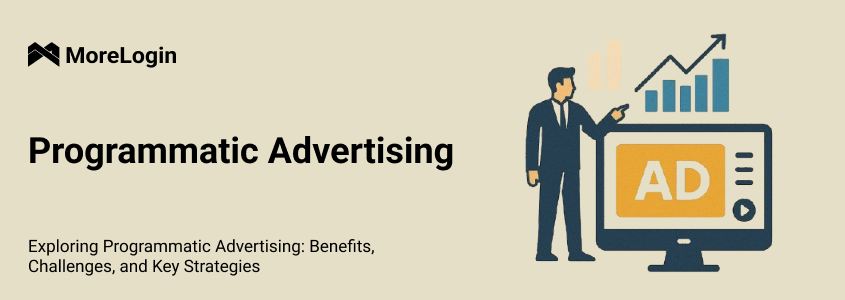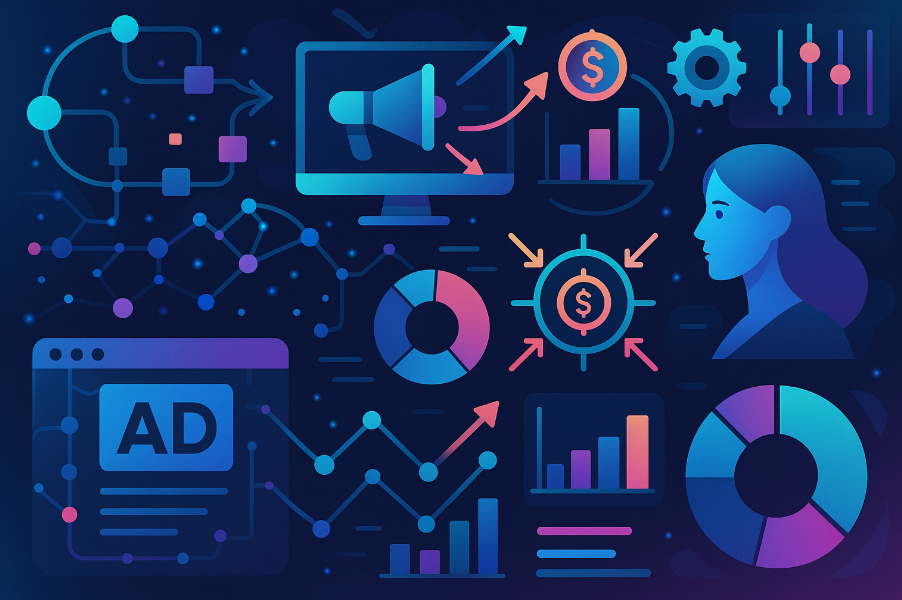
- Product

- Pricing
- Affiliate Program
- Use Cases
- Resource


Programmatic advertising is changing how companies buy digital media. According to eMarketer, programmatic spending made up more than 90% of all U.S. digital display ad spending in 2023. This number shows how important automation and targeting have become in online advertising.
Advertisers now use AI, data analysis, and real-time systems to deliver the right message to the right person at the right time. These tools make advertising faster, smarter, and more effective. This article explains what programmatic advertising is, outlines its benefits, addresses key challenges, and describes strategies to help advertisers succeed. Anyone looking to improve digital advertising results should understand this system.
Before choosing to invest in a new advertising method, businesses need to understand how the system works. Programmatic advertising relies on software to automate the process of buying digital ads. This replaces older systems that required people to handle deals manually.
Programmatic advertising means using automated technology to buy and sell digital ad space. The system uses software and algorithms to make decisions. It replaces old methods that used manual negotiations and phone calls.
The system includes several important features:
Automation: Software handles ad buying instead of people.
Real-time bidding (RTB): The system bids for ad impressions in milliseconds.
Data-driven targeting: The system uses user data to decide who sees each ad.
This technology helps advertisers reach people more accurately. It works across websites, mobile apps, and video platforms.
There are three main types of programmatic buying:
Open RTB: Ads are bought through public auctions.
Private marketplaces (PMPs): Publishers invite selected advertisers to bid.
Programmatic direct: Advertisers buy inventory at fixed prices without bidding.
These options give advertisers more control and better results.
Understanding the strengths of programmatic advertising helps marketers decide when to use it. Compared to traditional digital advertising, programmatic systems offer speed, scale, and improved targeting.
Programmatic advertising provides several key benefits:
Efficiency: Automated systems manage the process. This saves time and reduces manual work.
Precise targeting: Advertisers use data to reach the right people. This includes age, location, device, interests, and behavior.
Real-time changes: Advertisers can update budgets, creative content, and targeting while the campaign is live.
Clear results: Platforms show reports on clicks, impressions, conversions, and return on investment.
Scalability: The system delivers ads across many platforms and countries. It also supports different formats like banners, videos, and native ads.
These features make programmatic display advertising effective for small and large businesses alike.
While the benefits are significant, programmatic advertising also brings some challenges. Understanding these obstacles helps advertisers prepare and respond.

Data privacy laws: Advertisers must follow laws like GDPR and CCPA. They must collect and use data responsibly.
Ad fraud: Some bad actors create fake traffic or clicks. This wastes money. Advertisers must use tools to detect and prevent fraud.
Lack of transparency: Some advertisers do not know where their ads appear or how much they pay in fees. This reduces trust in the system.
Brand safety: Ads may appear next to harmful or inappropriate content. Advertisers must use blocklists and trusted platforms.
Technical complexity: Managing campaigns across platforms requires skill. Smaller teams may find it difficult.
Advertisers should invest in tools, training, and support to address these issues.
To make the most of programmatic advertising, advertisers need to understand the tools and systems behind it. The process involves different platforms and steps.
Programmatic advertising works through a set of systems:
Demand-Side Platforms (DSPs) help advertisers buy ad inventory.
Supply-Side Platforms (SSPs) help publishers sell ad space.
Ad Exchanges match buyers and sellers in real time.
Data Management Platforms (DMPs) collect and organize user data for targeting.
Advertisers can improve results with the following strategies:
Audience segmentation: Group users by interests, habits, or location.
A/B testing: Run different versions of ads and see which one performs better.
Geo-targeting: Show ads to users in specific regions or cities.
Time-based delivery: Show ads during certain hours or days.
Frequency capping: Limit how many times one person sees the same ad.
Cross-device targeting: Reach users across phones, tablets, and desktops.
Tool Highlight – Morelogin:
.png)
Morelogin is a tool that helps advertisers run many ad accounts at the same time, without getting banned or detected by platforms.
Manage multiple accounts:
Each account runs in a separate browser environment. Cookies, cache, and other data do not mix. This avoids any link between accounts. You can also sync profiles across devices or team members using the cloud sync feature.
Hide user information:
Morelogin changes your browser fingerprint to look like a real user. It can fake things like your browser type, screen size, time zone, fonts, and computer settings. This makes it harder for ad platforms to track or block you.
Use safe locations:
The tool supports residential proxies, mobile proxies, and datacenter IPs. You can choose the country or city of your IP address to match your campaign. This helps avoid geo-blocks and makes your access look more natural.
Why it matters for programmatic ads:
Ad platforms use fingerprinting to detect fraud or unusual behavior. Morelogin helps you stay hidden, manage accounts safely, and run global ad campaigns without problems.
Cost is often one of the first questions marketers ask when evaluating advertising options. Programmatic advertising costs vary, but the system provides a strong return when managed well.
Several elements affect the cost of programmatic advertising:
Cost per mille (CPM): Advertisers pay per 1,000 impressions. Prices depend on the audience and placement.
Platform fees: DSPs and SSPs take a share of the ad spend.
Data fees: Using third-party data may raise costs.
Creative costs: Producing ads also requires a budget.
Fraud protection: Many tools require an extra payment.
A smart advertiser watches performance and adjusts to improve results over time.
Many people confuse programmatic advertising with traditional digital advertising. However, the two approaches are quite different in how they work.
Programmatic advertising is part of digital advertising, but it offers automation and real-time control. Traditional digital advertising requires manual placements and more time.
With programmatic systems, advertisers:
Use software to buy ad space.
Make real-time decisions.
Use data to target better.
Change strategies during the campaign.
Manual digital advertising lacks the speed and targeting power of programmatic systems. Programmatic gives advertisers an edge in efficiency and accuracy.
Programmatic advertising gives advertisers more power, speed, and control. It lets them buy media faster, target audiences better, and track results more clearly.
To get the best results, advertisers must also handle challenges such as data laws and fraud. Tools like Morelogin can help improve account safety and global access.
Anyone who wants better digital campaigns should learn what programmatic advertising is and start using its full potential.
What is programmatic display advertising?
Programmatic display advertising refers to the automated buying and selling of banner or image-based ads across websites. It uses data and algorithms to place ads where they are most likely to be effective.
What is programmatic video advertising?
This type of advertising automates the placement of video ads on websites, apps, and streaming platforms. It allows advertisers to target specific audiences based on behavior and demographics.
Is programmatic advertising suitable for small businesses?
Yes. Programmatic platforms offer scalable options, which means businesses with smaller budgets can still access high-quality inventory and target users efficiently.